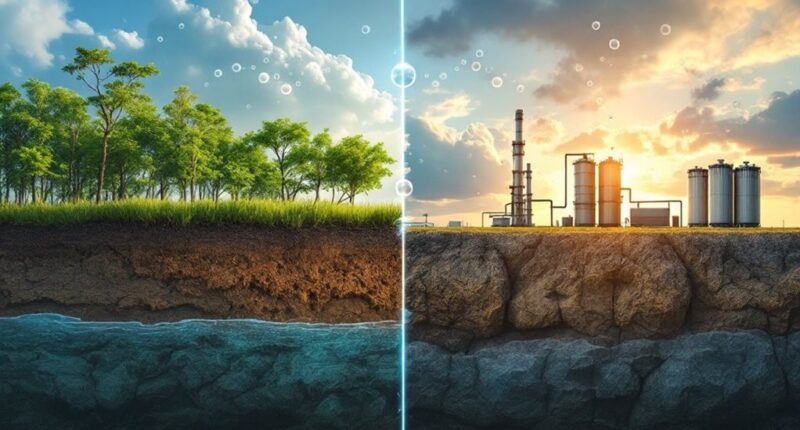Carbon sequestration methods span both nature’s toolkit and human innovation. Forests and oceans naturally capture over half of human CO2 emissions, while sustainable agriculture builds carbon-rich soil through conservation tillage and cover crops. On the tech side, engineers have developed direct air capture machines, carbon-negative concrete, and geological injection techniques that store carbon in depleted oil fields and saline aquifers. The battle against climate change continues on multiple fronts, from forest floors to laboratory doors.

The battle against climate change has found its silent hero in carbon sequestration—nature’s and humanity’s collaborative effort to capture and store atmospheric carbon dioxide. Like Earth’s own recycling system, forests sweep up a remarkable 30% of human-caused CO2 emissions, while oceans—those vast blue carbon vaults—lock away another 25% of our carbon indiscretions. It’s as if the planet has been preparing its defense mechanisms long before we understood the climate crisis.
In nature’s carbon ballet, forests and oceans perform an ancient dance, capturing over half our emissions before we knew we needed saving.
Nature doesn’t stop at forests, though. Grasslands and rangelands prove more reliable carbon squirrels in drought-prone regions, tucking away carbon nuts for long-term storage. Wetlands and mangroves are the unsung champions in this planetary game, sequestering carbon with an efficiency that would make industrial engineers jealous.
Even soil—yes, the dirt beneath your feet—stores organic carbon for decades, like a patient librarian archiving our atmospheric excess. Sustainable agriculture practices emphasize building soil organic matter, which naturally increases the land’s capacity to store carbon.
Humans, not to be outdone by nature, have engineered their own carbon-trapping toolkit. Geological sequestration—essentially giving carbon dioxide an underground retirement plan—involves injecting CO2 into depleted oil reservoirs, saline aquifers, and even unmineable coal seams. This approach allows for the continued fossil fuel use while society transitions to cleaner energy alternatives.
Basalt formations offer particularly cozy accommodations, quickly converting CO2 into stable carbonate minerals—think of it as carbon fossilization on fast-forward.
Farmers too have joined the sequestration squad. Conservation tillage, cover crops, and crop rotation aren’t just good farming—they’re carbon capture in disguise.
Agroforestry blends the best of both worlds, incorporating trees into agricultural systems like adding secret ingredients to a family recipe.
The tech world brings its own flavor to the carbon-catching party. Direct air capture machines act like atmospheric vacuum cleaners, while power plants employ chemical absorption towers to isolate CO2. These methods typically cost between $100-600 per metric ton of CO2 removed from the atmosphere.
Innovative approaches like carbon-negative concrete and engineered carbon-capturing molecules show that human ingenuity knows no bounds.
Urban environments haven’t been left out either. City reforestation, green building designs, and biochar production from waste transform our concrete jungles into carbon-trapping ecosystems, proving that sequestration isn’t just for remote wilderness—it’s happening right in our backyards.
Frequently Asked Questions
How Much Does Carbon Sequestration Cost per Ton?
Carbon sequestration costs vary greatly depending on the method used.
Natural approaches like reforestation run $10-$50 per ton, while wetland restoration costs $20-$100.
Technological options range widely: pre-combustion capture is relatively affordable at $15-$25 per ton, while direct air capture remains expensive at $94-$1,000 per ton.
Storage and transportation add $2-$50 per ton depending on location.
Costs continue to decrease as technologies advance and scale increases.
Can Carbon Sequestration Reverse Climate Change Completely?
Carbon sequestration alone cannot completely reverse climate change.
While natural and technological approaches can remove significant carbon, they face serious limitations. Current capacity represents just 0.1% of global emissions, and even projected increases fall short of net-zero targets.
Scientists estimate we’d need to remove about 20 billion tons CO2 annually – requiring a 45-fold increase in investment.
Complete climate reversal demands both massive carbon removal and dramatic emissions reductions across all sectors.
What Are the Risks of Geological Carbon Storage?
Geological carbon storage faces several key risks.
CO2 could escape through well failures or natural faults, potentially contaminating groundwater or reaching the surface. The pressure changes may trigger small earthquakes in some areas.
There’s also concern about CO2 displacing toxic brines into freshwater aquifers.
Technical challenges include predicting how CO2 will move underground and preventing infrastructure corrosion.
These risks necessitate thorough monitoring systems and careful site selection.
Which Countries Lead in Carbon Sequestration Technology?
The United States leads globally in carbon sequestration technology, commanding 60% of capture capacity with 154 projects in development.
The UK ranks second with 48 projects and a £20 billion commitment, followed by Canada with 45 projects and substantial tax credits.
China holds fourth place with 27 projects, including Asia’s largest coal-power plant CCS facility.
Norway rounds out the top five with 13 projects, including the groundbreaking Northern Lights initiative for industrial CO₂ management.
How Long Does Sequestered Carbon Remain Stored?
Sequestered carbon’s storage duration varies dramatically by method.
Natural options range from decades in forests to millennia in permafrost and ocean sediments.
Geological approaches offer impressive longevity, with underground injection lasting 10,000+ years and mineral carbonation potentially securing CO2 for millions of years.
Technologies like biochar provide centuries of storage, while direct air capture with geological storage rivals natural systems at 10,000+ years.
Storage permanence depends on factors like temperature, depth, and surrounding minerals.









